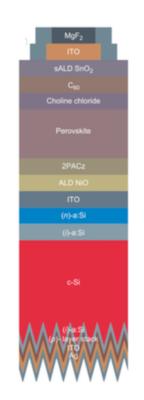Researchers from Eindhoven University of Technology, Delft University of Technology and TNO (partner in Solliance) have designed an integrated solar-assisted water-splitting system with a flow electrochemical cell and a monolithic perovskite-silicon tandem solar cell.
The team's work demonstrates how a perovskite/silicon tandem cell can be combined with a water electrolyzer system. However, the team said that there are still many steps that need to be taken before commercialization is possible. For example: upscaling the technology, addressing stability in greater detail, and use of more earth-abundant catalysts in the water-splitting reaction.
The scientists built an electrochemical (EC) flow cell with an active area of 4 cm2 and a two-compartment design. For the tandem solar cell, they combined a perovskite top cell and a bottom cell based on a silicon heterojunction architecture. They said the electrochemical and photovoltaic cells were wire-connected into an integrated solar-assisted water-splitting system.
The team tested the design on the lab scale of 1 cm2, which in principle can be extended to larger areas - however, some of the deposition methods will need the be adapted.
The top cell is based on a perovskite known as K0.05Cs0.05(FA0.79MA0.21)0.90Pb(I0.79Br0.21)3 with an energy bandgap of around 1.67 eV. They deposited the perovskite layer via atomic layer deposited (ALD) and applied magnesium fluoride (MgF2) as an anti-reflecting coating. They developed the device with a substrate made of glass and an indium tin oxide (ITO), a tin(IV) oxide (SnO2) buffer layer, an electron transport layer made of buckminsterfullerene (C60), the perovskite layer, and a hole transport layer made of carbazole (2PACz).
The research team used plasma-assisted atomic layer deposition (ALD) to place a nickel oxide (NiO) interlayer between the two cells and an ITO substrate as the interconnection layer. They designed the bottom cell with a conventional design based on amorphous silicon and crystalline silicon layers with the addition an ITO substrate and a silver (Ag) metal contact.
The champion tandem device built with this configuration achieved a power conversion efficiency of 25.1%, an open-circuit voltage of 1.80 V, a short-circuit current of 17.9 mA cm−2, and a fill factor of 0.78. According to the researchers, this system configuration is able to achieve a solar-to-hydrogen (STH) efficiency of over 21%.
“This STH efficiency is the highest reported for systems operating at approximately 1-Sun equivalent light intensity, and among the highest reported across a variety of combinations of EC and PV systems,” the team explained.
“We are interested to collaborate with commercial partners who are interested in making this a technology,” the researchers said. “The current design with the use of metals like indium (in the top electrode of the tandem cell), and platinum and ruthenium in the hydrogen and oxygen evolution catalysts needs replacement by more earth-abundant and cheaper alternatives. Examples of such materials are known, but we have not yet tested these.”




